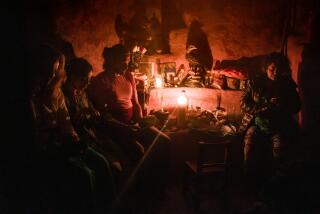Shamans Pose Live Puzzle for Anthropology
The Yanomami Indians of southern Venezuela and northern Brazil believe they turn into marauding spirits when they ingest a potent mixture of hallucinogenic plants.
A medicine man from Mexico’s Yucatan Peninsula uses a mixture of Christian chanting and pagan ritual to exorcise evil wind spirits that have possessed a sick child.
Some South American Indian tribes get sudden night vision and feel the spirits of jungle jaguars enter their bodies after massive ingestions of tobacco.
They are all examples of shamans, the medicine men of primitive cultures who believe they possess supernatural powers to heal, cause sickness, summon spirits and transform humans into animals.
They are also an enigmatic subject for anthropologists, who try to explain the phenomenon using scientific methods. Are shamans really endowed with supernatural powers or are they nimble-fingered charlatans? Can one trace trances and sudden healings to physiological or psychological causes?
Last weekend six prominent anthropologists examined shamans’ powers in tribal societies during a daylong symposium on shamanism held at Highland Park’s Southwest Museum. One thing seemed clear by the program’s end: Cultural traditions, psychotropic drugs and blind faith all play a major part in a shaman’s ability to perform seemingly supernatural deeds.
Interest in Paranormal Noted
Luann Hudson, one of two USC anthropologists who organized the symposium, said interest in the paranormal is on the rise today after a marked decline in the post-1960s. The symposium, sponsored by the USC anthropology department and the Southwest Museum, attracted about 220 participants, including students seeking credit, New Age practitioners in search of enlightenment, professional anthropologists, an art therapist, a jewelry designer and two theater directors.
Sander Johnson, director of the Los Angeles Mask Theater, which draws heavily on ritual and symbol for inspiration, said he thought the seminar went beyond the academic and into the experiences of the spirit world. Yet the decidedly academic panel walked a fine line between demystifying its subject and debunking it.
Interpretation Difficult
“It’s very difficult for us as anthropologists to interpret this in a way that is not hocus-pocus,” conceded Johannes Wilbert, a UCLA anthropology professor who has lived with South American Indians for 30 years.
Hudson and Suzanne Engler of USC sought to explain tales of shamanistic faith healing and transmigration from a primitive tribesman’s perspective. If one has grown up in a culture where the real and spirit worlds intertwine, the anthropologists argued, it takes no great leap of faith to believe that shamans can turn into animals or banish evil spirits.
However, “You take something like this out of its cultural context and . . . it’s not the same,” said Douglas Sharon, director of the San Diego Museum of Man.
Sharon’s research took him to Peru, where he worked with a middle-aged shaman named Eduardo whom he described as intelligent and learned and who used a wizard’s table cluttered with objects of good and evil to foretell the future and cure illness. Manipulating the shells, knives, stones and religious icons allowed him to manipulate his subjects’ lives as well, Sharon explained.
The anthropologists illustrated their talks with slides of rock art, colorful ceremonies and ritualistic objects. A documentary film showed the Yanomami Indians ingesting hallucinogenic snuff that they believed opened the doors of perception so that warlike spirits could invade their bodies.
Little Skepticism Apparent
There was little skepticism as seminar-goers stared solemnly at the screen. But was there any scientific explanation?
Wilbert said he believes a patient’s faith in the healer accounts for half the cure. Besides, the hallucinogenic native plants that shamans ingest as part of their religious rituals cause biological and emotional changes that confer seemingly supernatural powers, he said.
In his research, Wilbert found that many Indian cultures use staggering doses of tobacco, drinking up to a quart of tobacco-infused liquids or smoking numerous three-foot-long cigars, to achieve trance-like states in which they foretell the future, travel vast distances as spirits and transform themselves into powerful animals to wage war against enemy tribes.
For years, he said, Indian shamans from Brazil to Venezuela would tell him not to be alarmed when they suddenly turned into giant bats or man-eating jaguars after their rituals.
Intrigued, Wilbert embarked on a six-year pharmacological study of tobacco with help of a grant from the National Institute of Drug Abuse.
Findings to Be Published
Wilbert’s findings, contained in a forthcoming book published by Yale University Press called “Tobacco Ethnobotany of South America,” confirmed his beliefs that gigantic doses of tobacco produce many changes in the shaman. They can cause the respiratory system to stop and start suddenly, creating the illusion of death and resurrection. They can sharpen night vision or cause dimmed vision and loss of color perception, which might make the user believe he has descended into an underworld. Massive tobacco ingestion also causes the body to emit a pungent odor, turns the voice into a low growl and stimulates Adrenalin production, which quickens the fighting spirit.
“An Indian shaman novice can see at night like a jaguar, he smells like a jaguar, he feels like a jaguar . . . he has no problem believing he IS a jaguar,” Wilbert concluded.
Studying shamans in an Amazonian jungle is apparently a comfortable domain for anthropologists, but how about the shamans in East L.A., one seminar-goer wanted to know.
With the influx of immigrants from South and Central America, the panelists noted, mystical shamanistic experience probably has become common in California, perhaps through an underground network.
SHAMAN CAPTION
More to Read
Sign up for Essential California
The most important California stories and recommendations in your inbox every morning.
You may occasionally receive promotional content from the Los Angeles Times.










